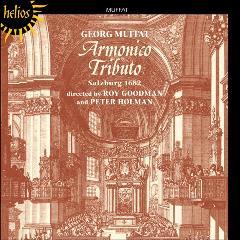Georg Muffat - Armonico Tributo (1982/2005)
Georg Muffat - Armonico Tributo (1982/2005)

Sonata No 1 in D major[11'50] 1.Sonata [3'10] 2.Allemanda [5'22] 3.Gavotta [1'41] 4.Menuet [1'37] Sonata No 2 in G minor[12'50] 5.Sonata [5'36] 6.Aria [2'45] 7.Sarabanda [2'59] 8.Borea [1'30] Sonata No 3 in A major[9'40] 9.Sonata [2'56] 10.Corrente [1'55] 11.Adagio [1'07] 12.Gavotta [1'14] 13.Rondeau [2'28] Sonata No 4 in E minor[7'35] 14.Sonata [1'11] 15.Balletto [1'13] 16.Adagio, alternating with Presto [1'51] 17.Menuet [1'36] 18.Adagio [0'31] 19.Aria [1'13] Sonata No 5 in G major[17'01] 20.Allemanda [2'39] 21.Adagio [1'13] 22.Fuga [1'34] 23.Adagio [2'29] 24.Passacaglia [9'06] Parley of Instruments Roy Goodman and Peter Holman - conductors
The five sonatas of Armonico Tributo were published in Salzburg in 1682, and are scored for two violins, two violas and basso continuo. Muffat, in his usual practical way, defined them as ‘chamber works suitable for few or many instruments’ and although the score is laid out with the letters ‘T’ and ‘S’ indicating tutti and solo passages, this seems to be something of an afterthought and the music seems well suited to single players. In the present performances therefore, there is an apparent ‘solo’ group of two violins, cello and continuo, to which is added a ‘tutti’ of two violas, bass and continuo.
Muffat explored the possibilities of the concerto principle in his later versions of these pieces, since most of the movements appear, albeit newly arranged, in his twelve concerti grossi. (Sonata I appears in Concerto V, Sonata II in Concerto IV, Sonata III in Concerto II, Sonata IV in Concerto XI, and Sonata V in both Concertos X and XII.) There is no fixed pattern for the sonatas, although there is clearly a strong French influence in the variety of dance movements (well-defined phrase lengths with simple harmony and flowing melody), and Italian influence in both the Grave or Adagio sections (either a simple punctuated succession of chords, or a sequence of suspensions above a ‘walking’ bass) and in the more contrapuntal and concertante Allegros.
Sonata I opens with a two-section Sonata in the Italian style – a passage of majestic harmony leads to a richly wrought fugue. It is followed by three French-style dances interspersed with short Grave passages of a type common in Corelli.
Sonata II is based on a similar pattern, though slightly expanded. Handel must have known this sonata; he used the tune and bass of the Aria in a number of works, including Agrippina, a recorder sonata and two organ concertos.
Sonata III also combines abstract Italian-style movements with French dances – after a short opening Grave in block chords there is a loosely written but brilliantly effective fugue on three subjects which are heard in most possible combinations and inversions. Of the following numbers, the short Adagio before the Gavotta is especially remarkable for its daring harmony.
Sonata IV opens again with a two-section Sonata, featuring a walking bass under rich suspensions of the type popularized by Corelli. After a lively Balletto, there is another favourite Corelli device – the alternating of Adagio passages for the whole ensemble with brilliant solos for the two violins and continuo alone. After a Menuet and a short Adagio, there is a Presto movement entitled Aria which is written in duple time, but which is intended to be played as a gigue in 12/8, using a notational convention common in German keyboard composers such as Froberger and Böhm.
Sonata V is rather differently laid out from the other four in that it does not start with a two-section Sonata, but with an expressive Allemanda. A complex fugue is then sandwiched between two Adagios, both of which again display the ‘walking’ bass and wonderful harmonic suspensions. The set ends with a magnificent Passacaglia containing twenty-five variations on a standard ground bass – related to the one used by Bach in the ‘Goldberg’ variations. Muffat was evidently pleased with this movement for he re-used it later in a modernized form at the end of his twelve concerti grossi of 1701. ---Roy Goodman, hyperion-records.co.uk
download (mp3 @320 kbs):
yandex 4shared mega mediafire uloz.to cloudmailru uptobox ge.tt








